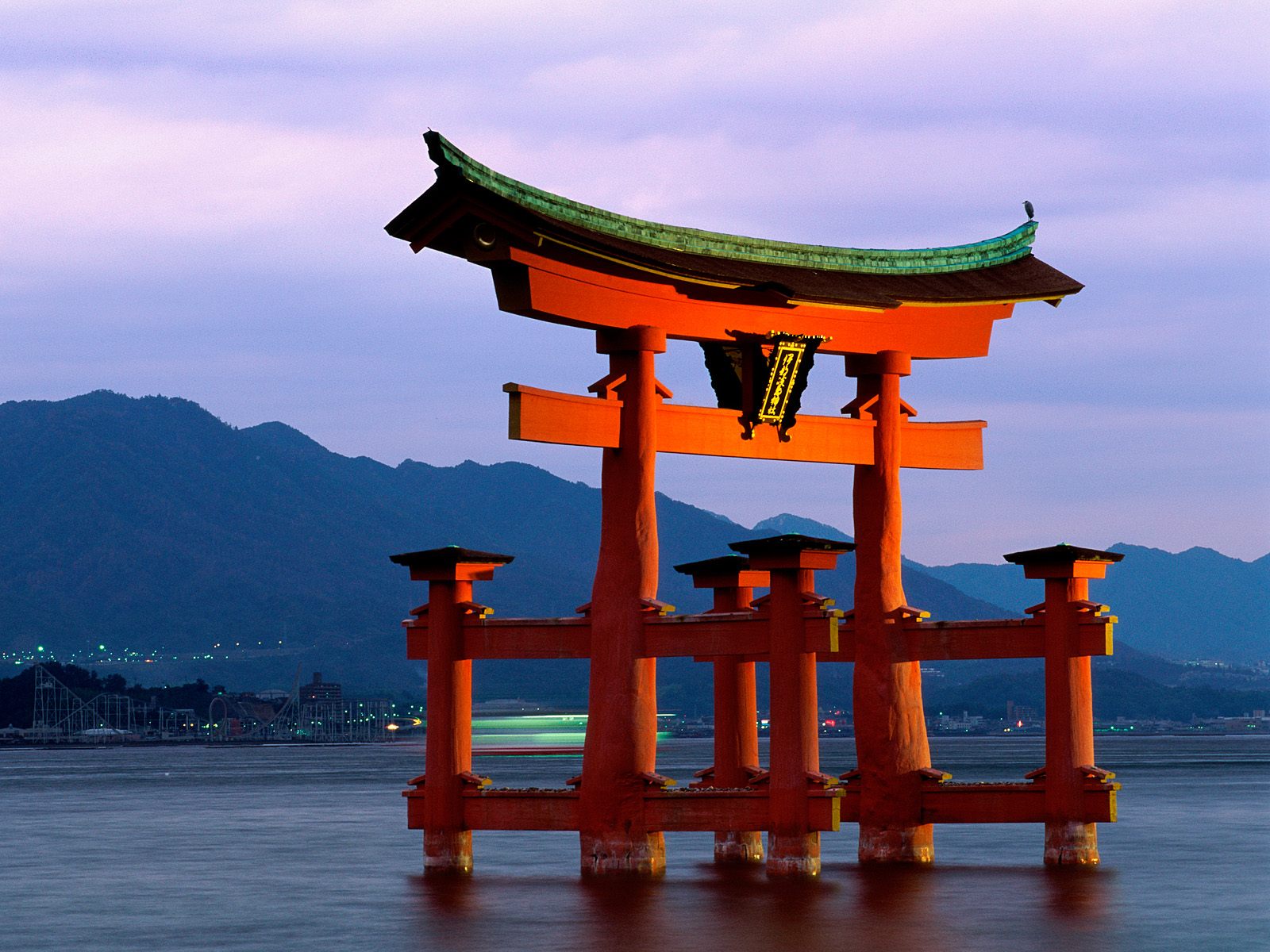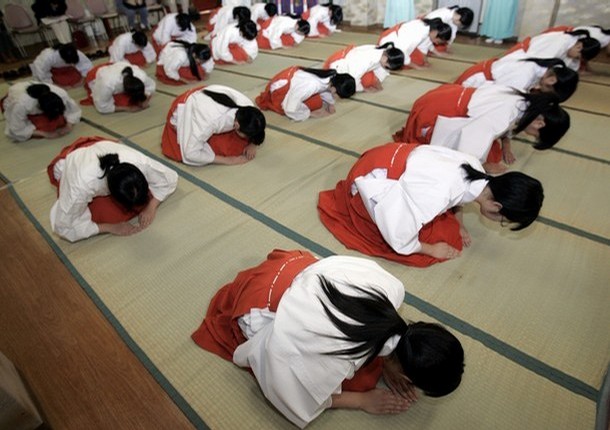![]() 刊登在 Japan - 社交娛樂 - 17 Apr 2016 05:26 - 4
刊登在 Japan - 社交娛樂 - 17 Apr 2016 05:26 - 4

Shinto is, above all, the deep expression of the ancient culture of the Japanese people. In this respect it may be compared to many of the animist religions of Black Africa which are practiced in certain specific ethnic groups.
Of course, the strength of Shinto is its being that of a particularly developed nation of more than 100 million inhabitants, but from a philosophic or religious point of view, Shinto is puzzling.
The origins of Shinto go back to the very earliest times and it is related rather to the animist religions of the ancient Siberian lations.
Shinto gives divine status equally to forces of nature, to animals or to famous people. These divinities are called " kamis " in Japanese and their Chinese equivalent is "shin". "To" or "do" mean "way" or "method" in Sino-Japanese. So Shinto is literally "the way of the gods". The most important god is the sun which, among its other virtues, serves as a protection against invasions. So, we can say that the Japanese flag is a Shinto symbol. The very name of the country, Nippon, is written with two Chinese characters : "ni", meaning "sun" and "pan", meaning "root" hence the translation Empire of the Rising Sun. Japan comes from the Chinese pronunciation of the same characters, Je-ben. However, the sun does not have a hierarchical role among the Shinto gods: each one has its place. The kami almost always inspire respectful fear. Among these we find mountains, animals like the tiger, the snake or the wolf ; and the Emperor himself. An imperial minister of the IXth century is the kami of calligraphy. There are allegedly 800 million kamis and the nickname given to Japan is Shinkoku, "country of the gods".
Shinto has no supreme God and heaven, and, unlike Chinese beliefs, it is not a divinity but the place where the kamis live. The kamis are thought to be intrinsically good but there are many exceptions. Prayers are made to the kami on various occasions for rain, good crops, the coronation of the Emperor etc.
In fact, Shinto has no established doctrine but is made up of a combination of practices which originally varied considerably from one village to another.

HISTORICAL EVOLUTION OF SHINTO
Right up until Japan’s first contacts with the Chinese civilisation, around the Vth century AD, Shinto consisted only of this combination of beliefs, myths and practices. It was a kind of polytheistic animism reminiscent, in the mixture of its divinities, of certain ancient religions as well as the animism of Black Africa.
At this period, Japan had virtually no writing, no painting or sculpture. This perhaps explains the absence of idols.
When China introduced Buddhism to Japan in 552 it had a twofold effect. On the one hand certain Shinto and Buddhist practices merged and on the other hand there arose a defensive reaction, of a rather nationalistic nature, in favour of Shintoism. The latter took shape in about the VIIIth century. The myths were unified and the patron kamis of the different clans or villages were given national status.
This movement, designed to strengthen the imperial government, went hand in hand with an attempt to write down these ancient traditions and to constitute a mythology, a priesthood and official "rituals". Another result was the proliferation of temples.
The entire religious history of Japan from then onwards was a succession of contradictory movements, now in favour of Buddhism, now of Shintoism.
So, in spite of a constant tendency to mix these two religions in an ill-defined syncretism, there are noticeable defensive reactions on the part of Shintoism round about the XIIIth and XVIIIth centuries. During this last period, Buddhism was the State religion and Shintoism appeared in a way, as a kind of resistance against the central authority.
In the Meiji period, in 1868, when Japan opened up to Western civilisation, the government forced Shinto and Buddhism to separate. The bonzes could no longer celebrate in Shinto temples and Buddhist texts could no longer be read there either.
Shintoism now took on four distinct forms:
* The Shinto of the Imperial House - comprising a rite of worship of the Sun goddess, Amerterasu o Mikami. This religious cult was formerly public but is nowadays strictly private.
* The Shinto of the Temples - These are the rituals practised in thousands of Japanese temples, united in one ociation, Jinja honcho. Both of these rites together constitute what is known as State Shinto, created at the beginning of the Meiji era and which lasted until the end of the second world war. It was in fact an institution designed to strengthen the Japanese identity and devotion to the Emperor.
* The Shinto of the sects - is the totality of the different movements born in the XIXth century. The best known of these was founded by a woman in 1838 and today numbers more than three million members. More will be said about these later.
* The Popular Shinto - This is a nebulous religiosity but it sometimes has magic practices. These four forms of Shinto are intermixed according to the cultural universe of each Japanese person and constitute the base of the value system of the country. That is why Shinto has become the privileged place of Japanese particularism and therefore nationalism. Only Shinto could confer upon the Emperor the divine character which favoured the designs of Japanese imperialism. The defeat of 1945 meant reducing the influence of this Shinto mechanism developed since Meiji. The Emperor Hiro-Hito agreed to limit Shinto to the role of a religious organisation among others. He himself explained that attachment to his people did not depend on the belief of his subjects in his divinity and he stopped the government subsidies to the Shinto temples. The Shintoists’ fervour with respect to the Emperor was not affected and the temples are still just as prosperous today.

THE PRACTICE OF SHINTO
Shinto is far more deeply seated in the social life of the Japanese than in their personal lives. Their religion of communion with nature in which everything is sacred, the stars, the rivers, the ancestors, famous people – is present in all Japanese traditions. In Sumo, a fight in which two very large semi-naked men try to push one another out of a circle, the notion of sport is almost secondary in relation to the rituals. The wrestlers throw down a handful of salt to purify the arena ; they kick one another in order to crush the forces of evil. As for the referee, he comes from a family specialised in this function and he is dressed as a Shinto priest.
The Nô theatre, codified in the XVth century, is simply the recitation of epic legends inspired by Shinto. Even Ikebana, a form of floral arrangement, is interpreted in terms of Shinto : the flowers have to indicate by the way they are placed the three planes of heaven, man and earth. Ikebana can also be interpreted in terms of Buddhist meditation. Until 1945 when the American occupation objected to it, O-Furo, mixed communal bathing , was seen as a ritual of communion with nature.
Today, the practice of Shinto does not imply any particular belief. The Japanese retain very little superstitious belief in the Kamis and they do not seek any rational justification for Shinto. Yet, for them, it is the expression of their belonging to the national community and participation in the Shinto ceremonies of their village or district shrine prove their willingness to maintain the harmony of the life of the nation.
The Japanese have celebrations according to the Shinto ritual to mark the special events in the life of individuals, of the community or the nation. These celebrations, called Matsuri, are simply occasions for rejoicing in being alive. They try to be pure in heart, to give expression to their gratitude for all the pleasurable things in the world and hope that happiness will continue to prevail.
There is no hope in a future life. Death is seen as a tragedy and they resort to a Buddhist rite which is more consoling to take care of it. On the other hand, extremely joyous Shinto celebrations are adapted for births and weddings. 90% of Japanese weddings are celebrated according to the Shinto rite. The chief symbol of the union of the spouses consists in drinking three times from the same cup of Saki. However, the traditional banquet to which family and colleagues are invited costs a fortune and so many young couples prefer to choose a wedding ceremony in a foreign country. They are not choosy about the wedding ritual. It is less expensive and the honeymoon trip is included in the price.
Families like to go to the Shinto temple on Sundays and enjoy walking in the gardens, carrying out purification rituals. They drink water from the sacred fountains from wooden goblets attached to the end of long stems. Another expression of Shintoism is what Westerners call, for want of a better word, "matsuri". It is an occasion on which to invite the deceased ancestors to celebrate the earthly joys and to have them take part in the spirit.

Yet, there is no real Shinto cult of the ancestors; what exists in this regard comes from Confucianism, that is to say, the Chinese culture.
Shinto has many pilgrimages, often in the mountains, the seat of the Kamis. The very simple moral code consists in avoiding serious sins: lies, murder, adultery etc.
By its very nature, Shinto is in no way incompatible with other religions since it is not in itself religious. Throughout its history it has fitted in with Buddhism and Confucianism and does not find any difficulty today in accommodating Christianity. Modern life has still further stripped it of its supernatural content, but Shinto continues to be an extraordinary binding force preserving Japanese unity.
It may seem surprising that a very "primitive" religion like Shintoism has nevertheless survived in Japan which is such a technically advanced civilisation. Shinto, in its vision of the universe , was already very far behind the technical evolution of Japan as it was before the advent of Buddhism. At that time, the agriculture and social structures of Japan had attained a level that can be seen, from the outside, to be very superior to the state of spirituality expressed in Shinto.
An interesting parallel may be drawn with Japanese writing which is both primitive and complicated. It could quite easily be replaced by the latin alphabet which is infinitely more efficient and well adapted to Japanese phonetics. The Japanese prefer, however, to keep an archaic system which is their own in order to protect their personality. Shinto is born of this spirit.
However, the Shintoist mentality is well adapted to the modern society it helps to mold and develop. The taste for nature favours ecological movements ; the need for constant renewal is an encouragement for the consumer society and the concern for beauty doubtless has an effect on the "design" and beauty of Japanese products.


贊助
Requiem評論 (4)

First

Weeaboos ! 


I always enjoy your articles, thank you


